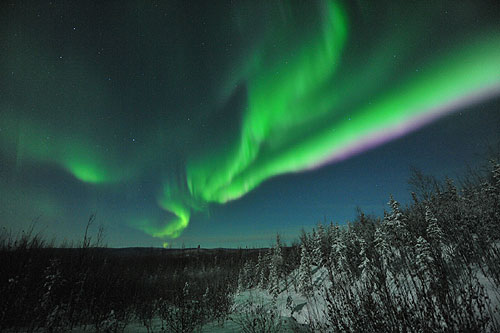 Alaska Science
Quiet time on the sun stalls
aurora viewing
Alaska Science
Quiet time on the sun stalls
aurora viewing
By NED ROZELL
November 30, 2009
Monday PM
It's a slow season for aurora watchers, due to an extra-long
quiet period on the great aurora generator-and all-around giver
of life-the sun.
"For two years we've been in an unusual, very low, extended
solar minimum," said Dirk Lummerzheim, an aurora forecaster
at the Geophysical Institute at the University of Alaska Fairbanks.
"That has an effect on aurora because aurora activity follows
solar activity. The aurora hasn't been too exciting lately."
 Poul Jensen of Fairbanks
took this photo near Old Murphy Dome Road on an exceptional aurora
night from Oct. 29-30, 2009.
Poul Jensen of Fairbanks
took this photo near Old Murphy Dome Road on an exceptional aurora
night from Oct. 29-30, 2009.
Photograph by Poul Jensen
Like the booms and busts of snowshoe hares, the numbers of both
solar flares and sunspots (dark splotches on the sun) peak about
every 11 years. On the other side of that peak is a crash, and
the sun has bottomed out in sporadic activity since early 2008.
The sun has gone more than two years without spewing a significant
solar flare, and sunspot counts have also been very low. And
sunspots are not great aurora indicators anyway.
"There's a statistical connection, but the appearance of
a sunspot doesn't guarantee aurora," said Roger Smith, a
space physicist and director of the Geophysical Institute. "It
isn't the sunspots that cause aurora; it's irregularities in
the solar wind that liberate energy for these beautiful optical
displays."
Syun-Ichi Akasofu, an expert on the aurora and former director
of both the Geophysical Institute and the International Arctic
Research Center, agrees that people place too much emphasis on
the connection between sunspots and aurora activity. He says
the presence of another irregularity on the surface of the sun-a
large, cool area called a coronal hole-often generates nice aurora
for those in the north as emissions from the hole rotate toward
Earth every 27 days or so.
According to Akasofu, we see more of the coronal hole type of
aurora than people in the Lower 48. He says: "The stream
from a coronal hole is weaker than a blast wave (caused by a
solar flare.) Sightings of this type of aurora are confined to
high latitudes, like Alaska. In Iowa, you won't see them."
Aurora sightings have been scarce in southern Alaska this year,
and forecasts have been tepid at http://www.gedds.alaska.edu/AuroraForecast/.
"In Anchorage, it's very difficult to see aurora,"
Lummerzheim says. "In Fairbanks, it's not too bad. If you
go to the Brooks Range, you get regular aurora, but we don't
have that big (solar) storm that pushes the aurora
south."
If you want to see aurora right now, at any cost, catch a flight
to Barrow or Kaktovik, Lummerzheim says.
"On the northern coast of Alaska, we have aurora every day,"
he says. "It may be boring aurora, a weak green glow just
over the horizon, but it's there."
But what goes down must go up, right? In the case of that awesome
nuclear reactor in the sky, scientists look to the past activity
as a possible predictor of what is to come. Except for a mysterious
70-year period without sunspots in the 17th century, solar cycles
have lasted from about nine to 14 years from trough to trough,
and the last bottoming out of solar activity was 13 years ago,
in 1996.
"We don't understand the physics of the sun enough to make
confident predictions," Lummerzheim says. "But the
general consensus is that we're getting into the end of the minimum,
and we expect (solar activity, and, perhaps, aurora sightings)
to go up as winter progresses."
This column is provided
as a public service by the Geophysical Institute,
University of Alaska Fairbanks, in cooperation with the UAF research
community.
Ned Rozell is a science writer at the institute.
E-mail your news &
photos to editor@sitnews.us
Publish A Letter in SitNews Read Letters/Opinions
Contact the Editor
SitNews
©2009
Stories In The News
Ketchikan, Alaska
|



